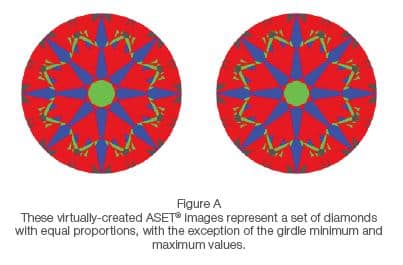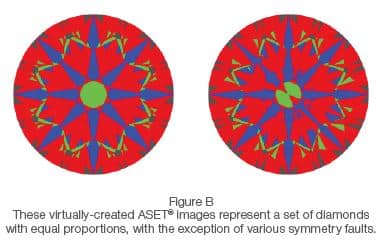by Brock Wilke, RJ, AGS Laboratories Research Analyst
When the American Gem Society® (AGS) was established in 1934, its purpose was to support the industry by creating a high code of ethics that emphasized consumer protection and education. After the AGS Laboratories® was founded, the AGS Light Performance system was created—an event that changed the industry. This new way of measuring cut quality combined the years of experience from highly-trained diamond professionals with the science and engineering of the time. The AGS Light Performance system raised the bar for the highest quality cut diamonds. There is no question that an AGS Triple Zero® diamond ranks at the top of performance and beauty, but is it possible for a diamond to fall short of an AGS Triple Zero® and still be beautiful?
The AGS cut grade system provides the consumer with the ability to separate badly cut diamonds from those cut to the best proportions and highest degree of accuracy. Like color and clarity, when showing diamonds, it is beneficial to provide a range of options that include diamonds that fit more comfortably into the customer’s budget.
There are certain sacrifices that can be made in regards to cut, which may not necessarily impact the overall beauty of the diamond. One of the 11 factors in the AGS cut grade system focuses on the girdle. Girdles that are too large or too small may hide unnecessary weight or create durability problems. A girdle measurement with maximum values of 5.0% and above, anywhere along the girdle, will result in a non-Ideal grade. Figure A shows a set of ASET® images from virtually-created diamonds. These diamonds have the same proportions, with the exception of the girdle. One diamond has a maximum value of 3.5% while the other is 5.3%.

The light performance of these two diamonds is nearly identical. Both are outstanding and get a light performance grade of AGS Ideal®. However, in terms of ovall cut grade, the diamond on the left would be AGS Ideal®, while the diamond on the right would be AGS Excellent due to the larger girdle thickness.
When grading for symmetry, there are some characteristics that are considered minor, while others would be considered major. Some minor faults do not impact the light performance of the diamond. They may also be impossible to see with the naked eye, even though the overall grade may reflect a non-Ideal diamond. Figure B shows a set of diamonds with the same proportions, with the one on the right having symmetry deductions that would result in a non-Ideal grade. These minor symmetry faults are noticeable in an ASET® image, but the light performance is still considered to be Ideal.

These two examples represent only a couple of possible scenarios of non-Ideal diamonds that will still be very pleasing to the eye. Choosing an AGS Triple Zero® gives the consumer the confidence and highest level of assurance regarding the beauty of the diamond. Those diamonds that fall just short of AGS Triple Zero® will still provide a great option, and may more comfortably fit a given budget.